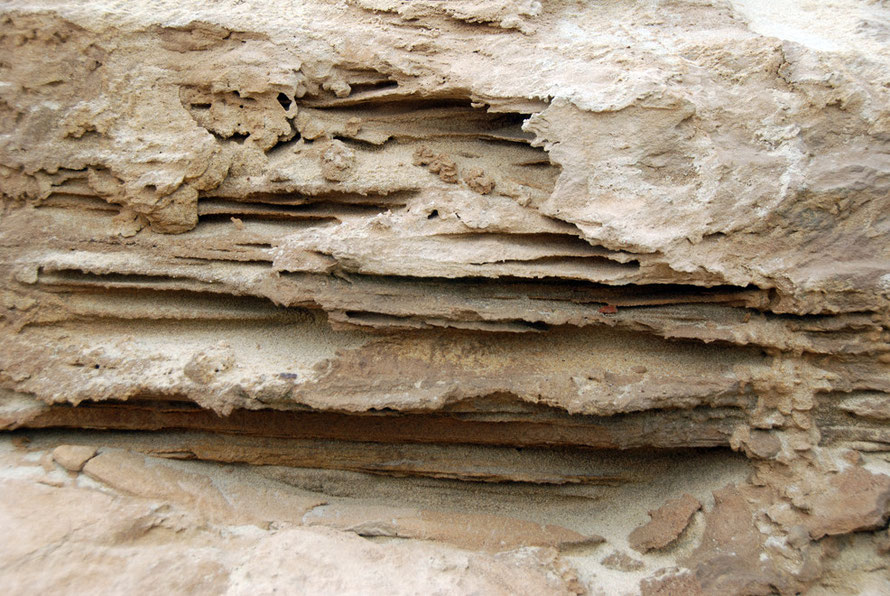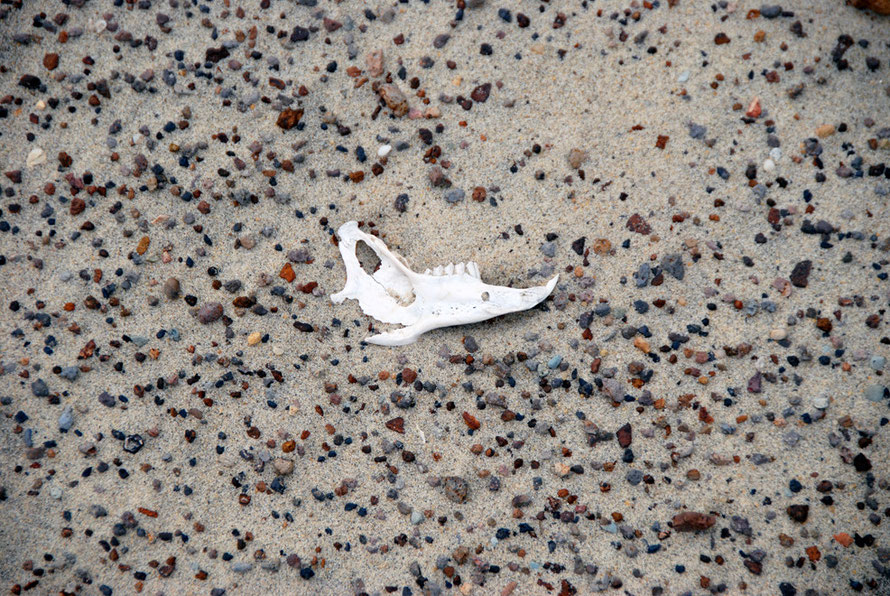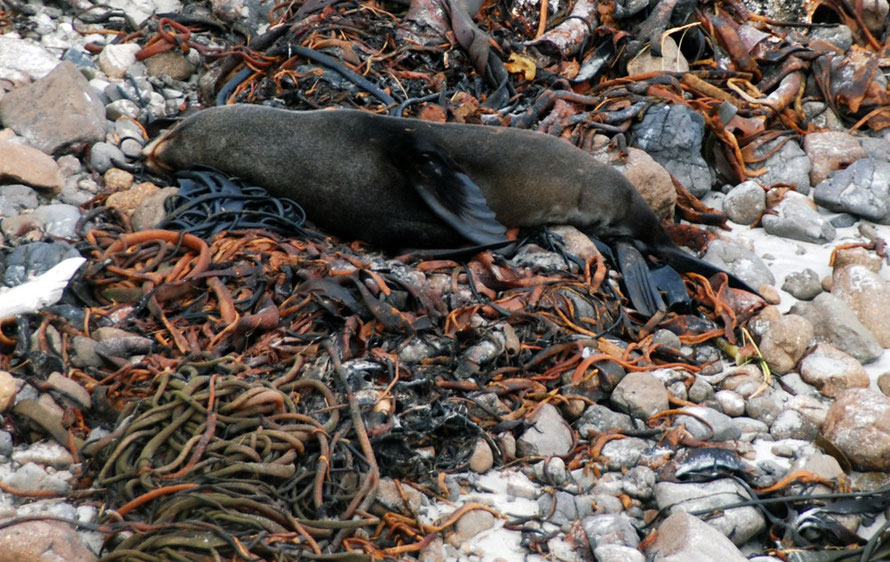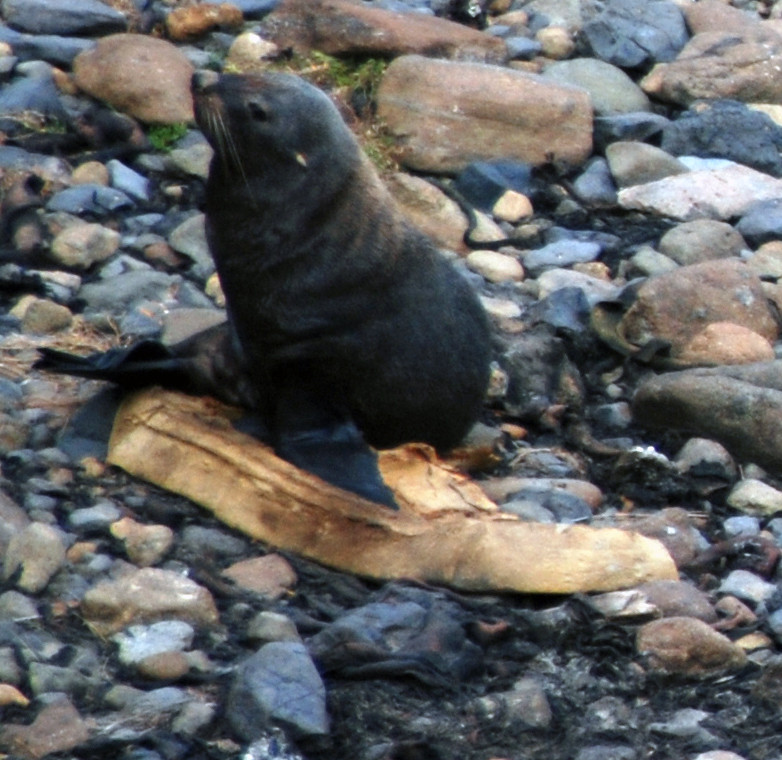Otago Peninsula IV: Sandfly Bay

Sandfly Beach is not, as we feared, named after the dreaded New Zealand Sand Fly. Instead it is named after the flying sands of the bay.
Facing directly south-west it catches the full force of the prevailing winds. Ocean currents running up the east side of the South Island carry sand from the river mouths of the Clutha/Mata-au and Taieri Rivers. Pacific swells shovel up the sand and drive it onto the beach.
Over thousands of years the wave-dumped and wind-blown sands have accumulated into deep layers and spread up the side of Sandymount/Pikiwhara to create an apron of sand dunes and broad sand valleys that reach 1000 feet (320m) above sea level.
We walked in via the Lovers Leap - a steep cleft ('zawn' in Cornwall) cut into the cliffs by wave action. The basalt column formation we had seen on Okia Flat was much in evidence here.
We then passed though an interesting patch of coastal bush - one of the few that has survived bush clearance on the Peninsula.
There were strange wind blown, tiny leaved very vertical shrubs on a surviving patch of silver tussock grass - New Zealand's native grassland. These were followed by a stretch of hillside covered in bushes running down to a pond.
After walking through this a magical little dell of giant fuschia trees and elder appeared. Three deep purple fuschia blossoms still clung on tenaciously even though we were into late very summer.
A survey of Otago's plants says that, 'Coastal slopes tend to have scrub dominated by Hebe elliptica and Olearia aviceniifolia, or sometimes by tree nettle' (P. Johnson, 2004, Otago Peninsula Plant List for Save The Otago Peninsula p.7).
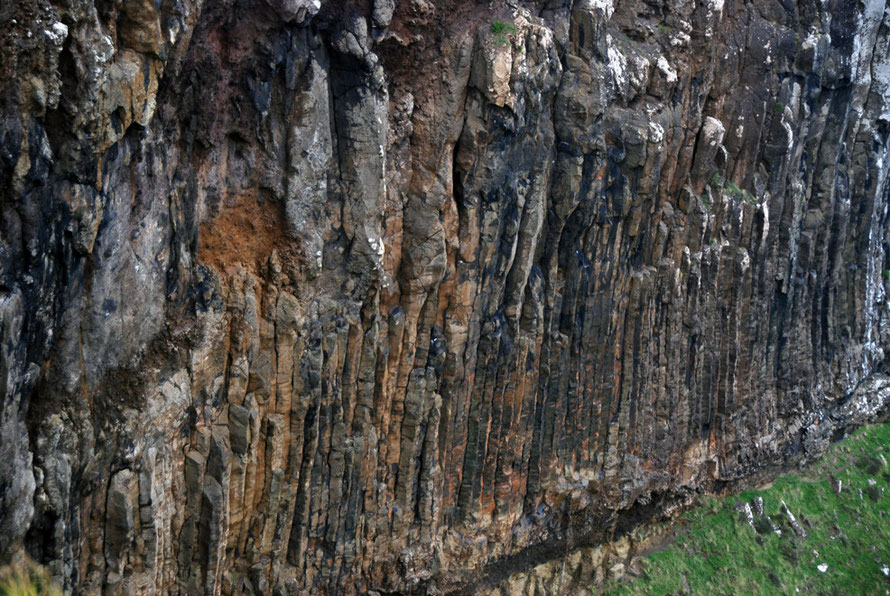
In his fantastic book, Ghosts of Gondwana, George Gibbs writes about the way that New Zealand shrubs have been impacted by the dominance of giant birds - the moa - and the absence of mammalian browsers. In effect, Moa were 'the ecological equivalents of antelope'.
He argues that this led to the evolution of particular shrubs - divaricates - that could protect themselves from over-plucking - rather than grazing - by the Moa. These divaricates are,
'small woody shrubs ...characterised by small leaves, tough stems, wide-angled branching, a dense interlocking meshwork of branches and multiple growing points inside the shrub' (p.162)
There are 50 species of divaricating shrubs in New Zealand in 17 different plant familes and Gibbs makes a convincing argument that this was due to a selective force that was not taking place elsewhere in the world.
In passing it is remarkable how benign the original vegetation of New Zealand appears to be. There are no thorn bushes and shrubs - like gorse, bramble and hawthorn and blackthorn (although they have been introduced and gorse is variously a problem or benefit to rejuvenating bush).

There is a deadly shrub - tutu - that will kill animals and humans alike. And its honey made from it can kill too.
I had overlooked the so-called nettle tree/ongaonga (Urtica ferox), that is endemic to New Zealand, has woody stems,unusually large stinging spines, and can grow 5 metres tall. Even the lightest touch can result in a painful sting that lasts several days. A man died from the stings in 1961 after stumbling through a dense patch of nettle trees.
It seemed like fun walking down the steep incline into a mini-desert. We ran into the very fit French tramper we had seen the previous day on Okia Flat. He was going up and labouring hard to get out of the back-sliding, powdery sand.
We stopped and exchanged a few words, the most important of which were, 'You are nearly at the top'.
We continued down into what felt like real wilderness under a misty, damp sky. Little trails of tiny footprints of small errant mammals ran across the sand slopes. Occassional red-topped poles marked out the increasingly hazy path as if we were crossing a treacherous icefield.
There were fantastic sand and ventifact (wind-carved) features as we continued our descent through the sand-fields. Beautiful patterns revealed in the under-layers of compacted sand with their distinctive basalt grains. Flakey-pastry displays and mini-boulder fields of wind scoured and polished rock. A bleached rabbit jawbone in a glittering constellation of sandstone, basalt and greywacke fragments. A strange skin of solidified sand etched away by the wind. And sand ('bunny') columns sculpted by the wind.

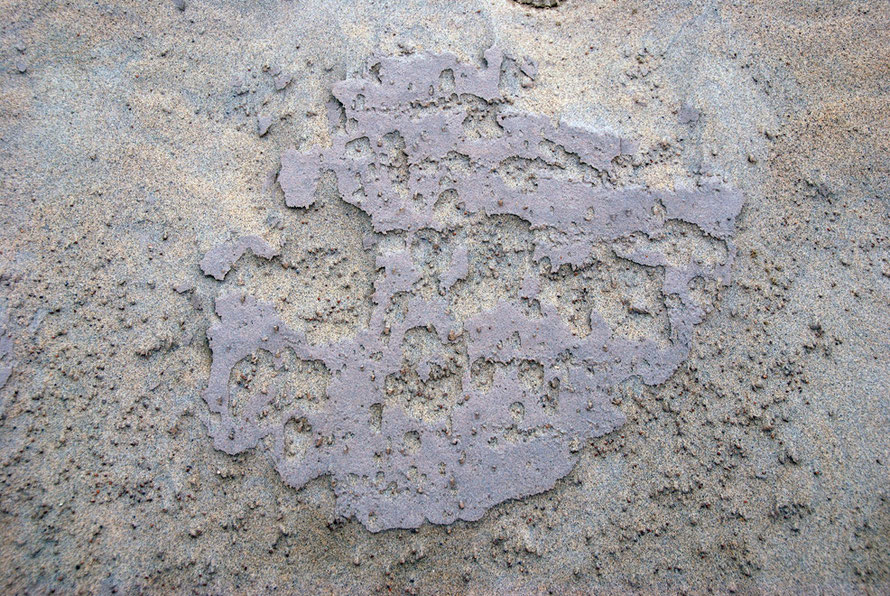
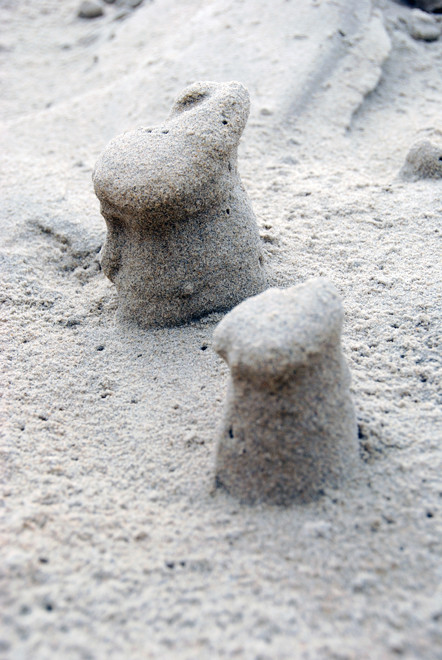
I picked up a stone carved by the wind. Its humped battleship grey surface studded by harder fragments and crystals resistant to the flying sand.
It seemed a tiny world, a microcosm, a contradiction of textures: the smooth, bright polished bottom and the cutting, jagged crystals revealed.
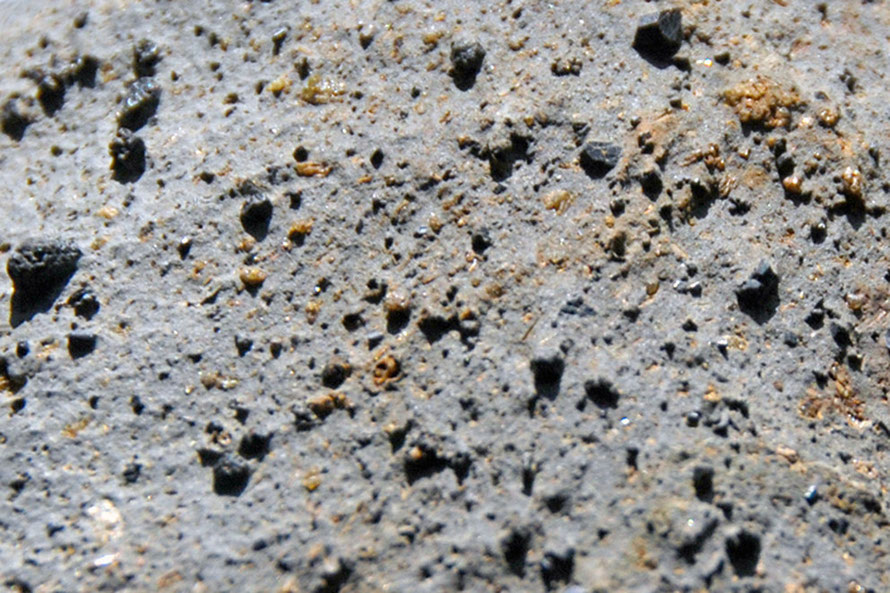
We emerged cautiously out onto the wasteland of the beach. A big turquoise sea was bashing in, line of swell upon line of swell. The sheer emptiness of the place was exhilarating.
The beach itself was littered with wrack: bull kelp in big tangled piles, huge logs of drift wood ripped from alpine slopes of the far interior and spat out by the mighty Clutha River to the south. And in the distance two sea lion bulls squaring up to each other in the drifting spray from the crashing waves.
'The principal' restrained me from approaching the beasts (and we had been warned by a sign on the descent to keep our distance) and I contented myself with fuzzy photos through the zoom lens. (See here for a separate page on rare New Zealand Sea Lion.)
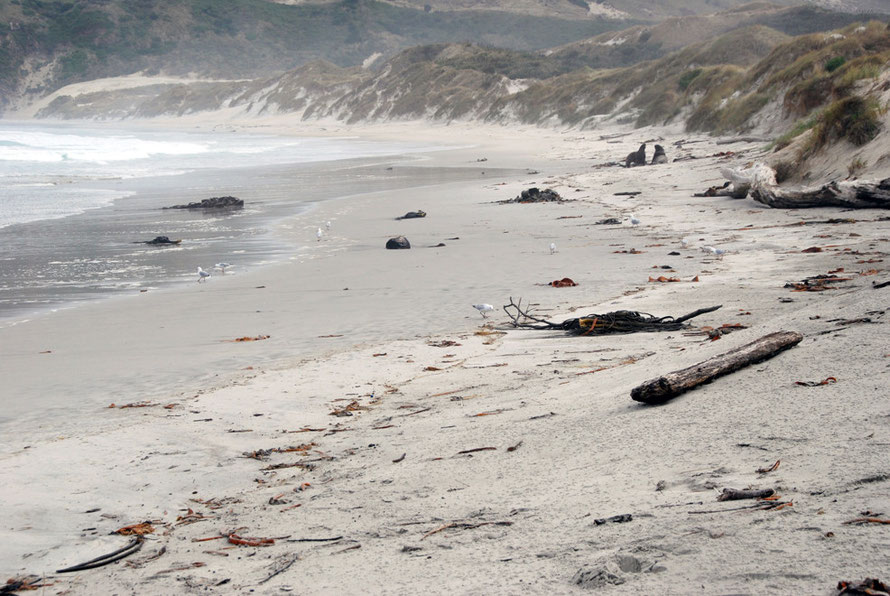
Later we trudged up the first wave of dunes to a wooden hide that looked out over the eastern end of the beach which turned into a rocky ledge. There were fur seals as far as the eye could see.
The hide was all ours and snug and we ate sandwiches and drank coffee from the flask.
The nearest seal was a big male (as far as I could tell) and he was stretched out in a luxurious manner over a mattress of olive green, black and orange bull kelp. We watched as he wriggled about, turning over and about, never finding the ideal spot. (See here for my page on New Zealand Fur Seals.)
Next to the restless male was a female who had actually found herself a piece of dirty foam on which to bed down.
The scene of stretched-out bliss is actually incredibly functional for fur seals that need to recuperate after their deep diving exploits. Otago fur seals are known to dive almost exclusively at night for their prey of squid, jack mackerel, conger eel, barracuda and hoki (a type of hake). They dive almost continuously from sundown to dawn. Female fur seals have recorded dives to depths of 238m and for a duration of 11 minutes.
In the summer Otago fur seals dive to 150-60m and in the winter they range further to the edge of the continental shelf and dive deeper (see Department of Conservation here).
Seaweeds on Sand Fly Beach
Eventually we had to trudge back up the great sandhill to the car park at Sandymount. It was a long hot climb and mercifully the sun stayed behind low lying cloud rolling in off the Pacific. By the time we got to the top all our water was gone.
But our spirits were high.



















